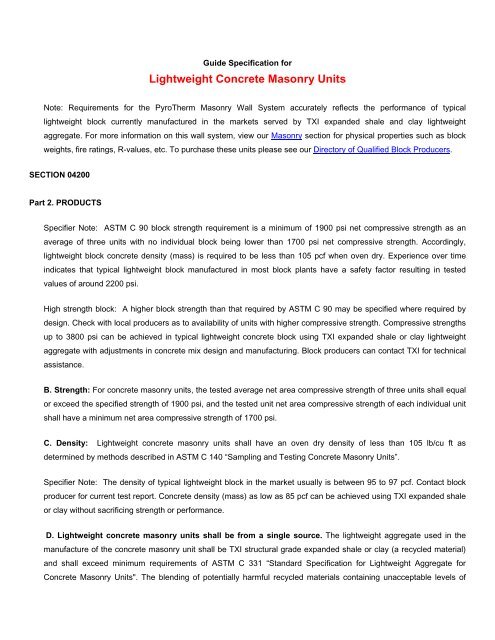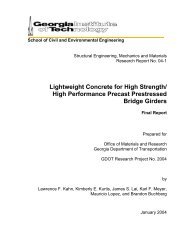Suggested Specification for Lightweight Concrete Masonry Units
Suggested Specification for Lightweight Concrete Masonry Units
Suggested Specification for Lightweight Concrete Masonry Units
- No tags were found...
You also want an ePaper? Increase the reach of your titles
YUMPU automatically turns print PDFs into web optimized ePapers that Google loves.
Guide <strong>Specification</strong> <strong>for</strong><strong>Lightweight</strong> <strong>Concrete</strong> <strong>Masonry</strong> <strong>Units</strong>Note: Requirements <strong>for</strong> the PyroTherm <strong>Masonry</strong> Wall System accurately reflects the per<strong>for</strong>mance of typicallightweight block currently manufactured in the markets served by TXI expanded shale and clay lightweightaggregate. For more in<strong>for</strong>mation on this wall system, view our <strong>Masonry</strong> section <strong>for</strong> physical properties such as blockweights, fire ratings, R-values, etc. To purchase these units please see our Directory of Qualified Block Producers.SECTION 04200Part 2. PRODUCTSSpecifier Note: ASTM C 90 block strength requirement is a minimum of 1900 psi net compressive strength as anaverage of three units with no individual block being lower than 1700 psi net compressive strength. Accordingly,lightweight block concrete density (mass) is required to be less than 105 pcf when oven dry. Experience over timeindicates that typical lightweight block manufactured in most block plants have a safety factor resulting in testedvalues of around 2200 psi.High strength block: A higher block strength than that required by ASTM C 90 may be specified where required bydesign. Check with local producers as to availability of units with higher compressive strength. Compressive strengthsup to 3800 psi can be achieved in typical lightweight concrete block using TXI expanded shale or clay lightweightaggregate with adjustments in concrete mix design and manufacturing. Block producers can contact TXI <strong>for</strong> technicalassistance.B. Strength: For concrete masonry units, the tested average net area compressive strength of three units shall equalor exceed the specified strength of 1900 psi, and the tested unit net area compressive strength of each individual unitshall have a minimum net area compressive strength of 1700 psi.C. Density: <strong>Lightweight</strong> concrete masonry units shall have an oven dry density of less than 105 lb/cu ft asdetermined by methods described in ASTM C 140 “Sampling and Testing <strong>Concrete</strong> <strong>Masonry</strong> <strong>Units</strong>”.Specifier Note: The density of typical lightweight block in the market usually is between 95 to 97 pcf. Contact blockproducer <strong>for</strong> current test report. <strong>Concrete</strong> density (mass) as low as 85 pcf can be achieved using TXI expanded shaleor clay without sacrificing strength or per<strong>for</strong>mance.D. <strong>Lightweight</strong> concrete masonry units shall be from a single source. The lightweight aggregate used in themanufacture of the concrete masonry unit shall be TXI structural grade expanded shale or clay (a recycled material)and shall exceed minimum requirements of ASTM C 331 “Standard <strong>Specification</strong> <strong>for</strong> <strong>Lightweight</strong> Aggregate <strong>for</strong><strong>Concrete</strong> <strong>Masonry</strong> <strong>Units</strong>". The blending of potentially harmful recycled materials containing unacceptable levels of
industrial contaminants as defined by the EPA or other deleterious substances which would impair fire ratings orinsulation values is prohibited. All units shall be free of organic impurities that will cause rusting, staining or popoutsand shall contain no combustible material.Fire Ratings: The producer of the concrete masonry units shall furnish certification from an independent testinglaboratory that concrete masonry units supplied to the project are deemed to comply with assumed fire ratings asdefined by code <strong>for</strong> individual block sizes. Submittals shall include the test reports indicating the equivalent thickness,materials used, and the calculated fire rating <strong>for</strong> each masonry unit size specified. Aggregates used will not impair firerating calculations <strong>for</strong> individual block sizes. See Item D. above.Specifier Note: All aggregates used in fire-rated concrete masonry must be aggregates listed in ACI 216, Table 1 –Fire resistance rating of concrete masonry assemblies as referenced by the IBC, Section 720 and 721. Claimsregarding fire-rated concrete masonry units manufactured using aggregates or recycled material aggregates not listedin Table 1 must be substantiated by full-scale fire wall testing according to the requirements of ASTM E 119 “StandardTest Methods <strong>for</strong> Fire Tests of Building Construction and Materials”. A copy of the ASTM E 119 test report <strong>for</strong>masonry containing non-standard materials should be requested indicating that the block intended <strong>for</strong> the project willper<strong>for</strong>m in a fire-rated assembly.Thermal Resistance: The producer of the concrete masonry unit shall, in the test report, report the concrete density(mass). Note: Refer to NCMA TEK 6-2A <strong>for</strong> conservative mid range R-values that can be used based on concretedensity.Specifier Note: The R-values <strong>for</strong> lightweight concrete masonry units increase dynamically due to less thermal bridgingthrough the masonry webs containing low density concrete when cores of the block are insulated.Certification and Testing: The producer of the block shall submit certifications of compliance with ASTM C 90, C331, C 33, and any other test requirements at least 60 days prior to any jobsite delivery. Field sampling of concretemasonry units shall be conducted during construction by an independent testing laboratory according to therequirements of ASTM C 140. Note: Field monitoring of lightweight concrete blocks can be accomplished by weighingdry units on-site.















